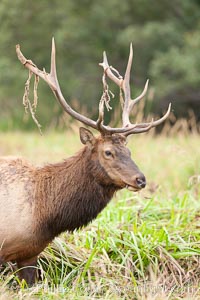
Roosevelt elk, adult bull male with large antlers. This bull elk has recently shed the velvet that covers its antlers. While an antler is growing, it is covered with highly vascular skin called velvet, which supplies oxygen and nutrients to the growing bone; once the antler has achieved its full size, the velvet is lost and the antler's bone dies. This dead bone structure is the mature antler, which is itself shed after each mating season. Roosevelt elk grow to 10' and 1300 lb, eating grasses, sedges and various berries, inhabiting the coastal rainforests of the Pacific Northwest.
Species: Roosevelt elk, Cervus canadensis roosevelti
Location: Redwood National Park, California
Image ID: 25901
Species: Roosevelt elk, Cervus canadensis roosevelti
Location: Redwood National Park, California
Image ID: 25901
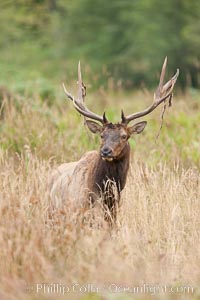
Roosevelt elk, adult bull male with large antlers. Roosevelt elk grow to 10' and 1300 lb, eating grasses, sedges and various berries, inhabiting the coastal rainforests of the Pacific Northwest.
Species: Roosevelt elk, Cervus canadensis roosevelti
Location: Redwood National Park, California
Image ID: 25902
Species: Roosevelt elk, Cervus canadensis roosevelti
Location: Redwood National Park, California
Image ID: 25902
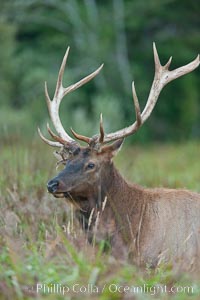
Roosevelt elk, adult bull male with large antlers. Roosevelt elk grow to 10' and 1300 lb, eating grasses, sedges and various berries, inhabiting the coastal rainforests of the Pacific Northwest.
Species: Roosevelt elk, Cervus canadensis roosevelti
Location: Redwood National Park, California
Image ID: 25903
Species: Roosevelt elk, Cervus canadensis roosevelti
Location: Redwood National Park, California
Image ID: 25903
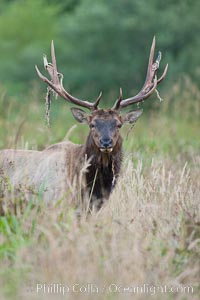
Roosevelt elk, adult bull male with large antlers. Roosevelt elk grow to 10' and 1300 lb, eating grasses, sedges and various berries, inhabiting the coastal rainforests of the Pacific Northwest.
Species: Roosevelt elk, Cervus canadensis roosevelti
Location: Redwood National Park, California
Image ID: 25904
Species: Roosevelt elk, Cervus canadensis roosevelti
Location: Redwood National Park, California
Image ID: 25904
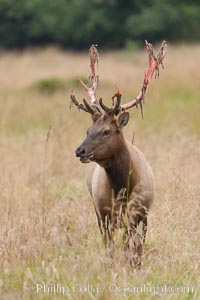
Roosevelt elk, adult bull male with large antlers. This bull elk has recently shed the velvet that covers its antlers. While an antler is growing, it is covered with highly vascular skin called velvet, which supplies oxygen and nutrients to the growing bone; once the antler has achieved its full size, the velvet is lost and the antler's bone dies. This dead bone structure is the mature antler, which is itself shed after each mating season. Roosevelt elk grow to 10' and 1300 lb, eating grasses, sedges and various berries, inhabiting the coastal rainforests of the Pacific Northwest.
Species: Roosevelt elk, Cervus canadensis roosevelti
Location: Redwood National Park, California
Image ID: 25905
Species: Roosevelt elk, Cervus canadensis roosevelti
Location: Redwood National Park, California
Image ID: 25905
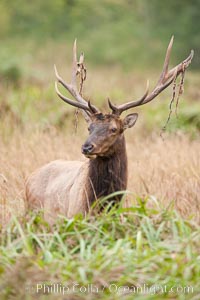
Roosevelt elk, adult bull male with large antlers. This bull elk has recently shed the velvet that covers its antlers. While an antler is growing, it is covered with highly vascular skin called velvet, which supplies oxygen and nutrients to the growing bone; once the antler has achieved its full size, the velvet is lost and the antler's bone dies. This dead bone structure is the mature antler, which is itself shed after each mating season. Roosevelt elk grow to 10' and 1300 lb, eating grasses, sedges and various berries, inhabiting the coastal rainforests of the Pacific Northwest.
Species: Roosevelt elk, Cervus canadensis roosevelti
Location: Redwood National Park, California
Image ID: 25907
Species: Roosevelt elk, Cervus canadensis roosevelti
Location: Redwood National Park, California
Image ID: 25907
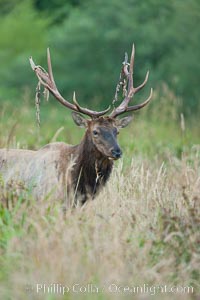
Roosevelt elk, adult bull male with large antlers. This bull elk has recently shed the velvet that covers its antlers. While an antler is growing, it is covered with highly vascular skin called velvet, which supplies oxygen and nutrients to the growing bone; once the antler has achieved its full size, the velvet is lost and the antler's bone dies. This dead bone structure is the mature antler, which is itself shed after each mating season. Roosevelt elk grow to 10' and 1300 lb, eating grasses, sedges and various berries, inhabiting the coastal rainforests of the Pacific Northwest.
Species: Roosevelt elk, Cervus canadensis roosevelti
Location: Redwood National Park, California
Image ID: 25908
Species: Roosevelt elk, Cervus canadensis roosevelti
Location: Redwood National Park, California
Image ID: 25908
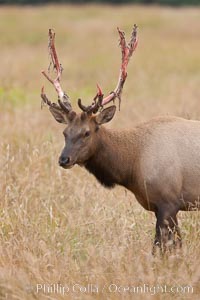
Roosevelt elk, adult bull male with large antlers. This bull elk has recently shed the velvet that covers its antlers. While an antler is growing, it is covered with highly vascular skin called velvet, which supplies oxygen and nutrients to the growing bone; once the antler has achieved its full size, the velvet is lost and the antler's bone dies. This dead bone structure is the mature antler, which is itself shed after each mating season. Roosevelt elk grow to 10' and 1300 lb, eating grasses, sedges and various berries, inhabiting the coastal rainforests of the Pacific Northwest.
Species: Roosevelt elk, Cervus canadensis roosevelti
Location: Redwood National Park, California
Image ID: 25909
Species: Roosevelt elk, Cervus canadensis roosevelti
Location: Redwood National Park, California
Image ID: 25909
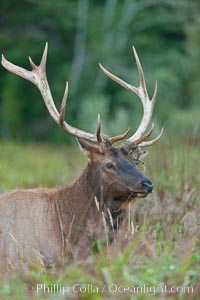
Roosevelt elk, adult bull male with large antlers. Roosevelt elk grow to 10' and 1300 lb, eating grasses, sedges and various berries, inhabiting the coastal rainforests of the Pacific Northwest.
Species: Roosevelt elk, Cervus canadensis roosevelti
Location: Redwood National Park, California
Image ID: 25911
Species: Roosevelt elk, Cervus canadensis roosevelti
Location: Redwood National Park, California
Image ID: 25911
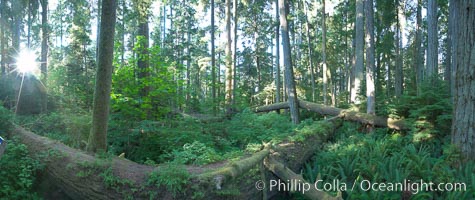
Cathedral Grove panorama, showing tall old-growth Douglas Fir trees. Cathedral Grove is home to huge, ancient, old-growth Douglas fir trees. About 300 years ago a fire killed most of the trees in this grove, but a small number of trees survived and were the originators of what is now Cathedral Grove. Western redcedar trees grow in adundance in the understory below the taller Douglas fir trees.
Species: Douglas fir, Pseudotsuga menziesii
Location: Cathedral Grove, MacMillan Provincial Park, Vancouver Island, British Columbia, Canada
Image ID: 21023
Panorama dimensions: 4089 x 9709
Species: Douglas fir, Pseudotsuga menziesii
Location: Cathedral Grove, MacMillan Provincial Park, Vancouver Island, British Columbia, Canada
Image ID: 21023
Panorama dimensions: 4089 x 9709
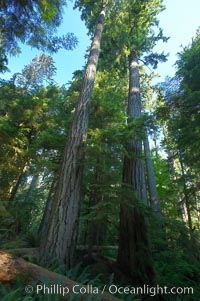
Ancient Douglas fir trees in Cathedral Grove. Cathedral Grove is home to huge, ancient, old-growth Douglas fir trees. About 300 years ago a fire killed most of the trees in this grove, but a small number of trees survived and were the originators of what is now Cathedral Grove. Western redcedar trees grow in adundance in the understory below the taller Douglas fir trees.
Species: Douglas fir, Pseudotsuga menziesii
Location: Cathedral Grove, MacMillan Provincial Park, Vancouver Island, British Columbia, Canada
Image ID: 21025
Species: Douglas fir, Pseudotsuga menziesii
Location: Cathedral Grove, MacMillan Provincial Park, Vancouver Island, British Columbia, Canada
Image ID: 21025
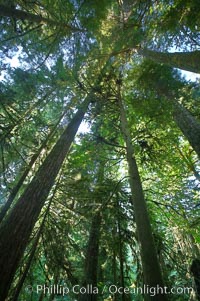
Ancient Douglas fir trees in Cathedral Grove. Cathedral Grove is home to huge, ancient, old-growth Douglas fir trees. About 300 years ago a fire killed most of the trees in this grove, but a small number of trees survived and were the originators of what is now Cathedral Grove. Western redcedar trees grow in adundance in the understory below the taller Douglas fir trees.
Species: Douglas fir, Pseudotsuga menziesii
Location: Cathedral Grove, MacMillan Provincial Park, Vancouver Island, British Columbia, Canada
Image ID: 21027
Species: Douglas fir, Pseudotsuga menziesii
Location: Cathedral Grove, MacMillan Provincial Park, Vancouver Island, British Columbia, Canada
Image ID: 21027
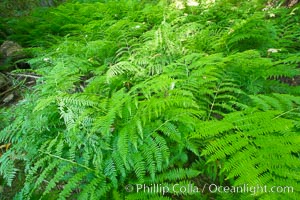
Ferns cover the forest floor of Cathedral Grove.
Location: Cathedral Grove, MacMillan Provincial Park, Vancouver Island, British Columbia, Canada
Image ID: 21031
Location: Cathedral Grove, MacMillan Provincial Park, Vancouver Island, British Columbia, Canada
Image ID: 21031
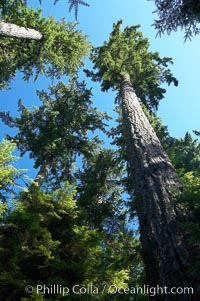
Ancient Douglas fir trees in Cathedral Grove. Cathedral Grove is home to huge, ancient, old-growth Douglas fir trees. About 300 years ago a fire killed most of the trees in this grove, but a small number of trees survived and were the originators of what is now Cathedral Grove. Western redcedar trees grow in adundance in the understory below the taller Douglas fir trees.
Species: Douglas fir, Pseudotsuga menziesii
Location: Cathedral Grove, MacMillan Provincial Park, Vancouver Island, British Columbia, Canada
Image ID: 21037
Species: Douglas fir, Pseudotsuga menziesii
Location: Cathedral Grove, MacMillan Provincial Park, Vancouver Island, British Columbia, Canada
Image ID: 21037
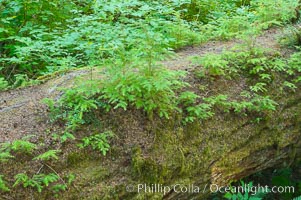
Nurse log. A fallen Douglas fir tree provides a substrate for new seedlings to prosper and grow.
Location: Cathedral Grove, MacMillan Provincial Park, Vancouver Island, British Columbia, Canada
Image ID: 21040
Location: Cathedral Grove, MacMillan Provincial Park, Vancouver Island, British Columbia, Canada
Image ID: 21040
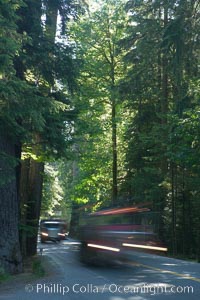
Logging truck speeding through Cathedral Grove. Cathedral Grove is home to some huge, ancient, old-growth Douglas fir trees. About 300 years ago a fire killed most of the trees in this grove, but a small number of trees survived and were the originators of what is now Cathedral Grove.
Location: Cathedral Grove, MacMillan Provincial Park, Vancouver Island, British Columbia, Canada
Image ID: 21041
Location: Cathedral Grove, MacMillan Provincial Park, Vancouver Island, British Columbia, Canada
Image ID: 21041
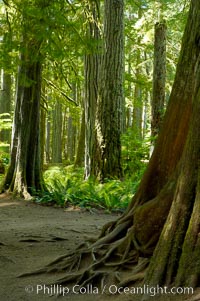
Western redcedar trees in Cathedral Grove. Cathedral Grove is home to huge, ancient, old-growth Douglas fir trees. About 300 years ago a fire killed most of the trees in this grove, but a small number of trees survived and were the originators of what is now Cathedral Grove. Western redcedar trees grow in adundance in the understory below the taller Douglas fir trees.
Location: Cathedral Grove, MacMillan Provincial Park, Vancouver Island, British Columbia, Canada
Image ID: 21044
Location: Cathedral Grove, MacMillan Provincial Park, Vancouver Island, British Columbia, Canada
Image ID: 21044
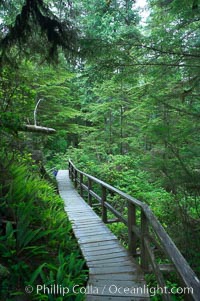
Rainforest Trail in Pacific Rim NP, one of the best places along the Pacific Coast to experience an old-growth rain forest, complete with western hemlock, red cedar and amabilis fir trees. Moss gardens hang from tree crevices, forming a base for many ferns and conifer seedlings.
Location: Rainforest Trail, Pacific Rim National Park, British Columbia, Canada
Image ID: 21051
Location: Rainforest Trail, Pacific Rim National Park, British Columbia, Canada
Image ID: 21051

Panorama of the Big Tree Trail on Meares Island, temperate rainforest home to huge red cedar and spruce trees.
Location: Meares Island Big Trees Trail, Tofino, British Columbia, Canada
Image ID: 21062
Panorama dimensions: 12484 x 4051
Location: Meares Island Big Trees Trail, Tofino, British Columbia, Canada
Image ID: 21062
Panorama dimensions: 12484 x 4051
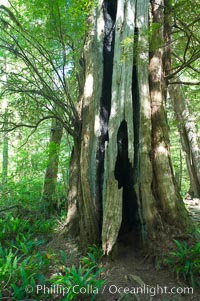
An enormous red cedar tree has been hit by lightning and burn through its core all the way to the ground, and still survives! The Big Tree Trail on Meares Island, temperate rainforest home to huge red cedar and spruce trees.
Location: Meares Island Big Trees Trail, Tofino, British Columbia, Canada
Image ID: 21063
Location: Meares Island Big Trees Trail, Tofino, British Columbia, Canada
Image ID: 21063
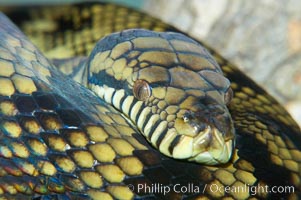
Amethystine python. The amethystine python is Australias biggest snake. They are nocturnal and arboreal, inhabiting tropical rainforests, monsoon forests and vine forests.
Species: Amethystine python, Morelia amethistina
Image ID: 12567
Species: Amethystine python, Morelia amethistina
Image ID: 12567
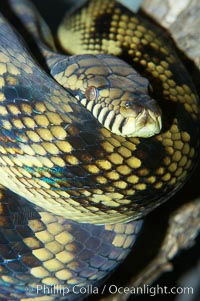
Amethystine python. The amethystine python is Australias biggest snake. They are nocturnal and arboreal, inhabiting tropical rainforests, monsoon forests and vine forests.
Species: Amethystine python, Morelia amethistina
Image ID: 12568
Species: Amethystine python, Morelia amethistina
Image ID: 12568
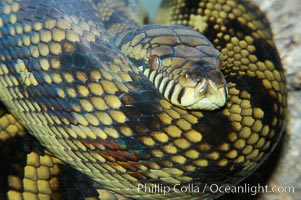
Amethystine python. The amethystine python is Australias biggest snake. They are nocturnal and arboreal, inhabiting tropical rainforests, monsoon forests and vine forests.
Species: Amethystine python, Morelia amethistina
Image ID: 12569
Species: Amethystine python, Morelia amethistina
Image ID: 12569
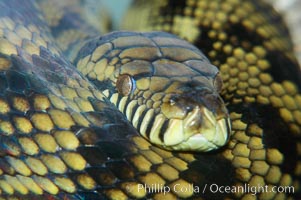
Amethystine python. The amethystine python is Australias biggest snake. They are nocturnal and arboreal, inhabiting tropical rainforests, monsoon forests and vine forests.
Species: Amethystine python, Morelia amethistina
Image ID: 12570
Species: Amethystine python, Morelia amethistina
Image ID: 12570
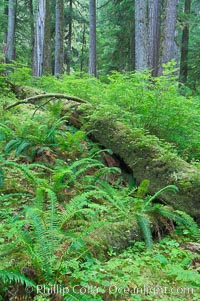
A fallen tree serves as a nurse log for new growth in an old growth forest of douglas firs and hemlocks, with forest floor carpeted in ferns and mosses. Sol Duc Springs.
Location: Sol Duc Springs, Olympic National Park, Washington
Image ID: 13755
Location: Sol Duc Springs, Olympic National Park, Washington
Image ID: 13755
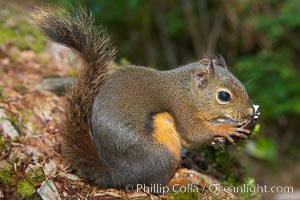
Douglas squirrel, a common rodent in coniferous forests in western North American, eats a mushroom, Hoh rainforest.
Species: Douglas squirrel, Tamiasciurus douglasii
Location: Hoh Rainforest, Olympic National Park, Washington
Image ID: 13776
Species: Douglas squirrel, Tamiasciurus douglasii
Location: Hoh Rainforest, Olympic National Park, Washington
Image ID: 13776
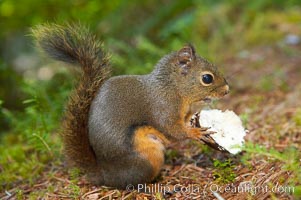
Douglas squirrel, a common rodent in coniferous forests in western North American, eats a mushroom, Hoh rainforest.
Species: Douglas squirrel, Tamiasciurus douglasii
Location: Hoh Rainforest, Olympic National Park, Washington
Image ID: 13777
Species: Douglas squirrel, Tamiasciurus douglasii
Location: Hoh Rainforest, Olympic National Park, Washington
Image ID: 13777
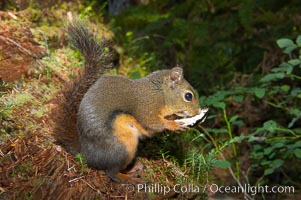
Douglas squirrel, a common rodent in coniferous forests in western North American, eats a mushroom, Hoh rainforest.
Species: Douglas squirrel, Tamiasciurus douglasii
Location: Hoh Rainforest, Olympic National Park, Washington
Image ID: 13778
Species: Douglas squirrel, Tamiasciurus douglasii
Location: Hoh Rainforest, Olympic National Park, Washington
Image ID: 13778
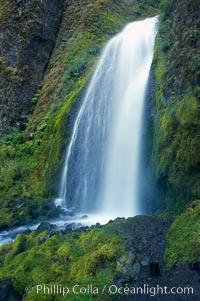
Wahkeena Falls drops 249 feet in several sections through a lush green temperate rainforest.
Location: Wahkeena Falls, Columbia River Gorge National Scenic Area, Oregon
Image ID: 19325
Location: Wahkeena Falls, Columbia River Gorge National Scenic Area, Oregon
Image ID: 19325
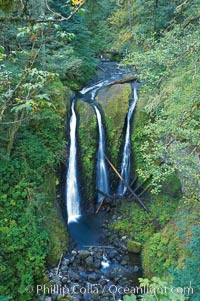
Triple Falls, in the upper part of Oneonta Gorge, fall 130 feet through a lush, beautiful temperate rainforest.
Location: Triple Falls, Columbia River Gorge National Scenic Area, Oregon
Image ID: 19327
Location: Triple Falls, Columbia River Gorge National Scenic Area, Oregon
Image ID: 19327